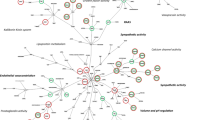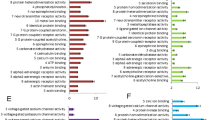Abstract
The utilization of approved medication is a requisite to combat certain diseases for health; however, the undesirable adverse effects (AEs) due to medication are generally unavoidable. Hypertension is one of such AEs resulting from approved medication in which blood pressure in the arteries gets elevated and is a risk factor for several diseases including heart and kidney failure. HTs are the approved drugs that can cause hypertension as an AE. Here, the goal of the study is to investigate the structural and functional diversities of HTs. In our quest to unravel the structural parameters of the HTs, a systematic analysis of the HTs having a different number and type of ring systems was conducted. The cellular component, molecular function and biological processes adopted by the gene products were analyzed. Moreover, our systematically done analysis suggests that all the target families are active in a common pathway, that is, nerve transmission. A comparison of the selected structural and functional aspect of HTs with anti-hypertensives suggests that HTs follow certain structural and functional features in spite of many possibilities. Our study provides a promising methodology that considers the influence of structural diversity of AE causing agents on a functional perspective for precursory clinical decision making. This could be extended to explore the structural and functional trends that are adopted by agents causing certain diseases or AEs.
Graphic abstract







Similar content being viewed by others
References
Lewis PR, Karpa KD, Felix TM (2015) Adverse effects of common drugs: adults. FP Essent 436:23–30
Cheng F, Kovács IA, Barabási A-L (2019) Network-based prediction of drug combinations. Nat Commun 10(1):1197
Lipinski C, Hopkins A (2004) Navigating chemical space for biology and medicine. Nature 432(7019):855–861
Clemons PA, Wilson JA, Dančík V, Muller S, Carrinski HA, Wagner BK, Koehler AN, Schreiber SL (2011) Quantifying structure and performance diversity for sets of small molecules comprising small-molecule screening collections. Proc Natl Acad Sci USA 108(17):6817–6822
Clemons PA, Bodycombe NE, Carrinski HA, Wilson JA, Shamji AF, Wagner BK, Koehler AN, Schreiber SL (2010) Small molecules of different origins have distinct distributions of structural complexity that correlate with protein-binding profiles. Proc Natl Acad Sci USA 107(44):18787–18792
Barabási A-L, Gulbahce N, Loscalzo J (2011) Network medicine: a network-based approach to human disease. Nat Rev Genet 12(1):56–68
Medina-Franco JL, Giulianotti MA, Welmaker GS, Houghten RA (2013) Shifting from the single- to the multitarget paradigm in drug discovery. Drug Discov Today 18:495–501
Medina-Franco JL (2012) Interrogating novel areas of chemical space for drug discovery using chemoinformatics. Drug Dev Res 73(7):430–438
Brown N, Jacoby E (2006) On scaffolds and hopping in medicinal chemistry. Mini-Rev Med Chem 6(11):1217–1229
Shang J, Sun H, Liu H, Chen F, Tian S, Pan P, Li D, Kong D, Hou T (2017) Comparative analyses of structural features and scaffold diversity for purchasable compound libraries. J Cheminform 9:25–40
Welsch ME, Snyder SA, Stockwell BR (2010) Privileged scaffolds for library design and drug discovery. Curr Opin Chem Biol 14(3):347–361
Bemis GW, Murcko MA (1996) The properties of known drugs. J Med Chem 39(15):2887–2893
Sharma AK, Srivastava GN, Roy A, Sharma VK (2017) ToxiM: a toxicity prediction tool for small molecules developed using machine learning and chemoinformatics approaches. Front Pharmacol 8:880–897
Limban C, Nuţă DC, Chiriţă C, Negreș S, Arsene AL, Goumenou M, Karakitsios SP, Tsatsakis AM, Sarigiannis DA (2018) The use of structural alerts to avoid the toxicity of pharmaceuticals. Toxicol Rep 5:943–953
Alves V, Muratov E, Capuzzi S, Politi R, Low Y, Braga R, Zakharov AV, Sedykh A, Mokshyna E, Farag S et al (2016) Alarms about structural alerts. Green Chem 18(16):4348–4360
Beck KR, Thompson GR, Odermatt A (2019) Drug-induced endocrine blood pressure elevation. Pharmacol Res 154:104311
Rubio-Guerra AF, Rodriguez-Lopez L, Vargas-Ayala G, Huerta-Ramirez S, Serna DC, Lozano-Nuevo JJ (2013) Depression increases the risk for uncontrolled hypertension. Exp Clin Cardiol 18(1):10–12
Li Z, Li Y, Chen L, Chen P, Hu Y (2015) Prevalence of depression in patients with hypertension. Medicine (Baltimore) 94(31):1317–1322
Ancker OV, Wehland M, Bauer J, Infanger M, Grimm D (2017) The adverse effect of hypertension in the treatment of thyroid cancer with multi-kinase inhibitors. Int J Mol Sci 18(3):625–743
Barton M, Prossnitz ER, Meyer MR (2012) Testosterone and secondary hypertension: new pieces to the puzzle. Hypertension 59(6):1101–1103
van Amsterdam J, Opperhuizen A, Hartgens F (2010) Adverse health effects of anabolic-androgenic steroids. Regul Toxicol Pharmacol 57(1):117–123
Chen S-Y, Fan S-Z, Chen L-K (2013) Ultralow dose combined spinal–epidural anesthesia for cesarean section in ritodrine-related severe pulmonary hypertension. Taiwan J Obstet Gynecol 52(4):617
Spiekerkoetter E, Fabel H, Hoeper MM (2002) Effects of inhaled salbutamol in primary pulmonary hypertension. Eur Respir J 20(3):524–528
Oskarsson A, Ullerås E, Ohlsson Andersson Å (2016) Acetaminophen Increases Aldosterone Secretion While Suppressing Cortisol and Androgens: a Possible Link to Increased Risk of Hypertension. Am J Hypertens 29(10):1158–1164
Law V, Knox C, Djoumbou Y, Jewison T, Guo AC, Liu Y, Maciejewski A, Arndt D, Wilson M, Neveu V et al (2014) DrugBank 4.0: shedding new light on drug metabolism. Nucl Acids Res 42:D1091–D1097
The UniProt Consortium (2017) UniProt: the universal protein knowledgebase. Nucl Acids Res 45(D1):D158–D169
Hammer Ø, Harper DAT, Ryan PD (2001) PAST: paleontological statistics software package for education and data analysis. Palaeontologia Electronica 4(1):9
Leeson PD, Springthorpe B (2007) The influence of drug-like concepts on decision-making in medicinal chemistry. Nat Rev Drug Discov 6(11):881–890
Siegel MG, Vieth M (2007) Drugs in other drugs: a new look at drugs as fragments. Drug Discov Today 12(1–2):71–79
Dalvie D, Nair S, Kang P, Loi C-M (2010) Chapter 6: Influence of aromatic rings on ADME properties of drugs. In: metabolism, pharmacokinetics and toxicity of functional groups. The royal society of chemistry, pp 275–327
Worley JD (1993) Heterocyclic chemistry, second edition (Gilchrist, T.L.). J Chem Educ 70(3):A89
Adriani J, Yarbrough WM (1972) Drugs containing halogen atoms: toxicity and lack of toxicity. J Med Assoc Georgia 61(10):347–351
Hernandes MZ, Cavalcanti SMT, Moreira DRM, de Azevedo Junior WF, Leite ACL (2010) Halogen atoms in the modern medicinal chemistry: hints for the drug design. Curr Drug Targets 11(3):303–314
Benarroch EE (2011) Na+, K+-ATPase: functions in the nervous system and involvement in neurologic disease. Neurology 76(3):287–293
Nikolic LM (2016) Regulation of Na+/K+-ATPase activity in the nervous system. In: Dhalla NS, Chakraborti S (eds) Regulation of membrane Na+-K+ATPase. Springer, Cham, pp 295–309
Shih JC, Chen K, Ridd MJ (1999) Role of MAO A and B in neurotransmitter metabolism and behavior. Pol J Pharmacol 51(1):25–29
Kim Y-B, Kim Yoon S, Kim Woong B, Shen F-Y, Lee Seung W, Chung Hyun J, Kim Jeong S, Han Hee C, Colwell Christopher S, Kim Yang I (2013) GABAergic excitation of vasopressin neurons. Circ Res 113(12):1296–1307
Zomot E, Bendahan A, Quick M, Zhao Y, Javitch JA, Kanner BI (2007) Mechanism of chloride interaction with neurotransmitter: sodium symporters. Nature 449:726
Czapski GA, Czubowicz K, Strosznajder JB, Strosznajder RP (2016) The Lipoxygenases: their regulation and implication in alzheimer’s disease. Neurochem Res 41:243–257
Li Y, Maher P, Schubert D (1997) A role for 12-lipoxygenase in nerve cell death caused by glutathione depletion. Neuron 19(2):453–463
Yan N (2015) Structural biology of the major facilitator superfamily transporters. Annu Rev Biophys 44(1):257–283
Olivares AM, Moreno-Ramos OA, Haider NB (2016) Role of nuclear receptors in central nervous system development and associated diseases. J Exp Neurosci 9(Suppl 2):93–121
Manville RW, Papanikolaou M, Abbott GW (2018) Direct neurotransmitter activation of voltage-gated potassium channels. Nat Commun 9(1):1847
Coceani F (1974) Prostaglandins and the central nervous system. JAMA Internal Med 133(1):119–129
Traynelis SF, Wollmuth LP, McBain CJ, Menniti FS, Vance KM, Ogden KK, Hansen KB, Yuan H, Myers SJ, Dingledine R (2010) Glutamate receptor ion channels: structure, regulation, and function. Pharmacol Rev 62(3):405–496
Siddiqi N, Shatat IF (2019) Antihypertensive agents: a long way to safe drug prescribing in children. Pediatr Nephrol 7:4314–4330
Roush GC, Sica DA (2016) Diuretics for hypertension: a review and update. Am J Hypertens 29(10):1130–1137
Savitha MN, Suvilesh KN, Siddesha JM, Gowda M, Choudhury M, Velmurugan D, Umashankar M, Vishwanath BS (2019) Combinatorial inhibition of angiotensin converting enyme, neutral endopeptidase and aminopeptidase n by n-methylated peptides alleviates blood pressure and fibrosis in rat model of dexamethasone-induced hypertension. Peptides 123:170180
Xue H, Lu Z, Tang WL, Pang LW, Wang GM, Wong GWK, Wright JM (2015) First-line drugs inhibiting the renin angiotensin system versus other first-line antihypertensive drug classes for hypertension. Cochrane Database Syst Rev 1:CD008170
Li C, Yan X, Wu D, Zhang K, Liang X, Pan Y, Zhou Y, Chen F, Chen X, Yang S et al (2019) Vaccine targeted alpha 1d-adrenergic receptor for hypertension. Hypertension 74(6):1551–1562
Zablotskaya A, Segal I, Geronikaki A, Shestakova I, Nikolajeva V, Makarenkova G (2017) N-Heterocyclic choline analogues based on 1,2,3,4-tetrahydro(iso)quinoline scaffold with anticancer and anti-infective dual action. Pharmacol Rep 69(3):575–581
Solomon VR, Lee H (2011) Quinoline as a privileged scaffold in cancer drug discovery. Curr Med Chem 18(10):1488–1508
Mishra AP, Bajpai A, Rai AK (2019) 1,4-Dihydropyridine: a dependable heterocyclic ring with the promising and the most anticipable therapeutic effects. Mini Rev Med Chem 19(15):1219–1254
Acknowledgements
RS thanks Department of Biotechnology, BioCARe, New Delhi, for the financial assistance through DBT Grant (BT/PR18249/BIC/101/390/2016), IICT manuscript number IICT/Pubs./2019/277. The funders had no role in study design, data collection and analysis, decision to publish or preparation of the manuscript. Special thanks to Dr. Kavya, Indian Institute of Science, for the critical review and discussions of the manuscript.
Author information
Authors and Affiliations
Contributions
RS conceived the idea, designed, performed, analyzed and drafted the manuscript.
Corresponding author
Ethics declarations
Conflict of interest
None declared.
Additional information
Publisher's Note
Springer Nature remains neutral with regard to jurisdictional claims in published maps and institutional affiliations.
Electronic supplementary material
Below is the link to the electronic supplementary material.
Rights and permissions
About this article
Cite this article
Sharma, R. Data science-driven analyses of drugs inducing hypertension as an adverse effect. Mol Divers 25, 801–810 (2021). https://doi.org/10.1007/s11030-020-10059-5
Received:
Accepted:
Published:
Issue Date:
DOI: https://doi.org/10.1007/s11030-020-10059-5




